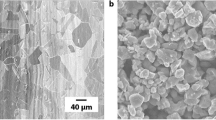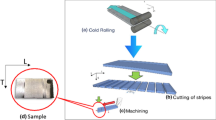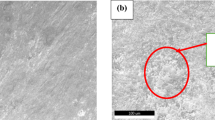Conclusions
-
1.
Microhardness, abrasive grain strength, and abrasive power are not reliable criteria of the wear resistance of abrasive tools in the grinding of materials at high speeds. An understanding must be obtained of the mechanism by which the abrasive and work materials react with each other in the contact zone.
-
2.
The abrasive power of most carbonitrides exceeds that of white electroco undum, but is less than that of green silicon carbide.
-
3.
With rise in MeC content, the abrasive power of carbonitrides grows. The abrasive qualities of vanadium carbonitrides are particularly high, while zirconium carbonitrides are characterized by low abrasive power.
-
4.
The majority of carbonitrides surpass green silicon carbide in wear resistance in the microcutting of titanium. Carbonitrides of low nitrogen content have very high wear resistance. The wear resistance of titanium carbonitrides is a linear function of their MeC content; the wear resistance of zirconium, vanadium, and niobium carbonitrides is represented by curves with minima at composition of about MeC0.4N0.6.
Similar content being viewed by others
Literature cited
V. D. Sil'vestrov, in: Fundamental Problems in High-Productivity Grinding [in Russian], Mashgiz, Moscow (1960), p. 153.
G. I. Sayutin, V. M. Snovidov, and N. I. Bogomolov, Fiz.-Khim. Mekhan. Mat.,7, No. 5, 22 (1971).
G. V. Samsonov, A. Ya. Artamonov, and A. I. Bezykornov, Poroshkovaya Met., No. 6, 86 (1968).
G. V. Samsonov, A. Ya. Artamonov, and I. F. Idzon, Poroshkovaya Met., No. 11, 75 (1967).
G. V. Samsonov et al., Properties of Refractory Compounds (Concise Reference Tables) [in Russian], Izd. IPM Akad. Nauk USSR, Kiev (1972).
K. I. Portnoi, A. A. Mukoseev, et al., Poroshkovaya Met., No. 5, 87 (1968).
A. I. Bezykornov, N. I. Bogomolov, and M. S. Koval'chenko, Poroshkovaya Met., No. 11, 77 (1970).
Methods of Testing of Granulated Synthetic Abrasive Materials [in Russianj, VNIIASh, Moscow (1963).
M. G. Bogdanovich, O. V. Ginzburg, et al., Sintetich. Almazy, No. 2, 12 (1972).
G. V. Samsonov, in: Refractory Carbides [in Russian], Naukova Dumka, Kiev (1970), p. 9.
N. I. Bogomolov, Stanki i Instrument, No. 9, 22 (1956).
Author information
Authors and Affiliations
Additional information
Translated from Poroshkovaya Metallurgiya, No. 4 (136), pp. 79–83, April, 1974.
Rights and permissions
About this article
Cite this article
Adamovskii, A.A., Bezykornov, A.I. & Bilyk, I.I. Abrasive properties and wear resistance of some transition-metal carbonitrides. Powder Metall Met Ceram 13, 318–321 (1974). https://doi.org/10.1007/BF00796809
Received:
Issue Date:
DOI: https://doi.org/10.1007/BF00796809




